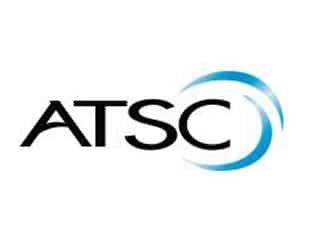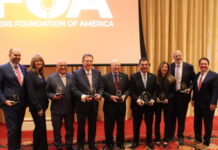Not convinced that consumer awareness and growth of NEXTGEN TV across the U.S. is accelerating as quickly as Pearl TV and the team at the ATSC broadcast standards association says it is? The 2025 NAB Show is poised to serve as yet another reminder that the consumer-forward gadgetry bringing clearer picture and improved sound to broadcast TV is broader than ever — and going global.
No less than 24 from around the world are attending the Las Vegas conference and expo, which started Sunday, with the intent of showcasing new options for next-generation broadcasting. And, they will also be present in the ATSC booth, located in the West Hall of the Las Vegas Convention Center at #W3056.
Interactivity and High Dynamic Range (HDR) are the two key play-up points for the ATSC.
ATSC President Madeleine Noland comments, “As the Broadcast Standards Association, ATSC is proud to count nearly 60 ATSC member companies exhibiting throughout this year’s NAB Show. It’s through their innovations and collaboration that we can empower the broadcasting ecosystem, which is our mission.”
The ATSC West Hall exhibit will include “a wide variety of international companies, brands, products and services that demonstrate how internet protocol-based transmissions can enhance entertainment and information for viewers and provide a new delivery pipe for data through ATSC 3.0,” Noland adds.
The largest displays inside the ATSC booth will be from AT&T Business, HCLTech, Sinclair’s ONE Media entity, and Tejas Networks. AT&T Business will demonstrate reliable communications at venues and in high-traffic environments, while HCLTech will showcase its Broadcast Core Network, a cloud offering that brings “flexible deployment of applications and services across different markets leveraging AI and integrates components from various sources, independent of the underlying infrastructure.”
Sinclair and ONE Media are planning demonstrations of the variety of ATSC 3.0 features that will be possible when, not if, broadcasters sunset ATSC 1.0. This includes 4K High Dynamic Range video, emergency alerting and information, and data services from Broadspan. Lastly, Tejas Networks will show direct-to-mobile content delivery, integrating broadcast and broadband, enabling real-time media access with low network congestion, ATSC boasts.
CONSUMER CHOICES ABOUND
NEXTGEN TV sets will be on display at the ATSC booth, and they include recent NEXTGEN TV entrants Panasonic and RCA. They’ll join models from Hisense, Samsung, Sony, and TCL.
Upgrade Accessory Receivers are coming in a variety of implementations. If this were 2019, this probably wouldn’t have existed, as ATSC backers and Pearl TV was insistent that the consumer would naturally replace their set with a newer NEXTGEN TV-compatible device by the time ATSC 3.0 signals were put in place. That didn’t transpire, as the COVID-19 pandemic and a shaky economy yielded add-on tools for a system that isn’t backward compatible. The “UAR” devices include USB receivers to more fully-featured digital video recorders and combo ATSC 3.0 over-the-air/over-the-top media players. Upgrade Devices will be on display from ADTH, MyVelo, Stavix, VBox, Zapperbox, and Zinwell.
In the ATSC booth, Advanced HDR by Technicolor will demonstrate its premium High Dynamic Range viewing experience for broadcast and streaming of live sports and entertainment. Also on display, HDR10+ Technologies LLC will be demonstrating TV sports content in High Dynamic Range with HDR10+ metadata on the latest compatible ATSC 3.0 televisions from Panasonic and Samsung.
A BPS DENVER TEST IS SHARED
Additionally, upward of 20 conference sessions will discuss the capabilities of the ATSC 3.0 broadcast standard. This include a Sunday (4/6) session at West Hall meeting room 220-221 at 11:20am that shares details of a field test of ATSC 3.0/BPS precise time distribution.
The NAB is heavily pushing its own Broadcaster Positioning System as a reliable alternative to GPS, and is powered by ATSC 3.0 digital broadcast technology’s datacasting side. The optional BPS protocol inserts metadata into the ATSC 3.0 frame, allowing receivers to estimate signal time-of-flight and to identify the time-of-transmission of frame symbols with high precision and accuracy. In principle, BPS enables an independent radio positioning service and may derive its time reference with complete independence from GPS/GNSS, with little constraints on air-chain implementation.
In collaboration with the NAB and Nexstar Media Group’s KWGN-TV in Denver, NIST tested several aspects of time transfer stability in a BPS field deployment. KWGN transmitted ATSC 3.0/BPS from a position west of Denver. Signals were received at the station’s studio some 30km to the north and the NIST WWVB radio station near Fort Collins, some 64 miles away.
The propagation is believed to be line-of-sight except to NIST in Boulder, which is located in a slight valley.
INTERNATIONAL DRIVING
Eight international exhibitors will be featured at kiosk displays in the ATSC exhibit in the LVCC’s West Hall.
Software providers Fraunhofer (Germany), Happiest Minds (India), Mirakulo (Brazil), Run3TV (USA), Tolka (Singapore), and Yotta Media Labs (United Kingdom) will each show different applications of how ATSC 3.0 can be applied to benefit broadcasters and viewers. Advanced HDR by Technicolor (USA and Netherlands) and VBox (Israel) are also exhibiting.
Fraunhofer IIS will demonstrate ATSC 3.0 with MPEG-H Audio, which is part of DTV+, Brazil’s Next Generation TV System, and an advanced audio system for broadcast and streaming applications providing more realism through immersive sound and unique personalization features.
Happiest Minds will show how to unlock the power of ATSC 3.0 with their NEXTGEN TV app that enabled enhanced engagement, personalized content, and location-aware television.
Mirakulo will present AstroTV NEXT, integrating hybrid interactivity, over-the-top, live TV, metrics, and dynamic ad insertion.
Run3TV will highlight the business case for Smart Broadcasting, which is now available from hundreds of U.S. broadcasters and offers the ability to launch new consumer-friendly services like Program Re-Start.
Tolka will show a wide variety of devices with built-in ATSC 3.0 – including a model that offers real-time Artificial Intelligence automatic translations from English to Spanish, Chinese, Japanese, and more.
VBox will demonstrate an ATSC 3.0 Datacasting Terminal, as well as a commercial ATSC 3.0 receiver for use in hospitality and senior living centers.
Yotta Media Labs will showcase how broadcast can add stations on ATSC 3.0 via a hybrid model, including using magicBOX for station delivery, event streams, exciter protection, and more.




